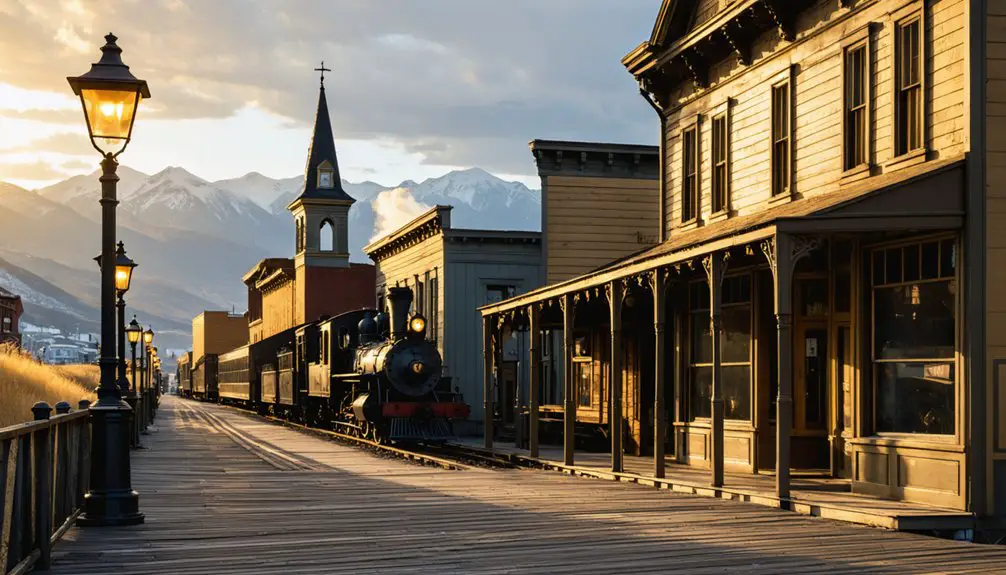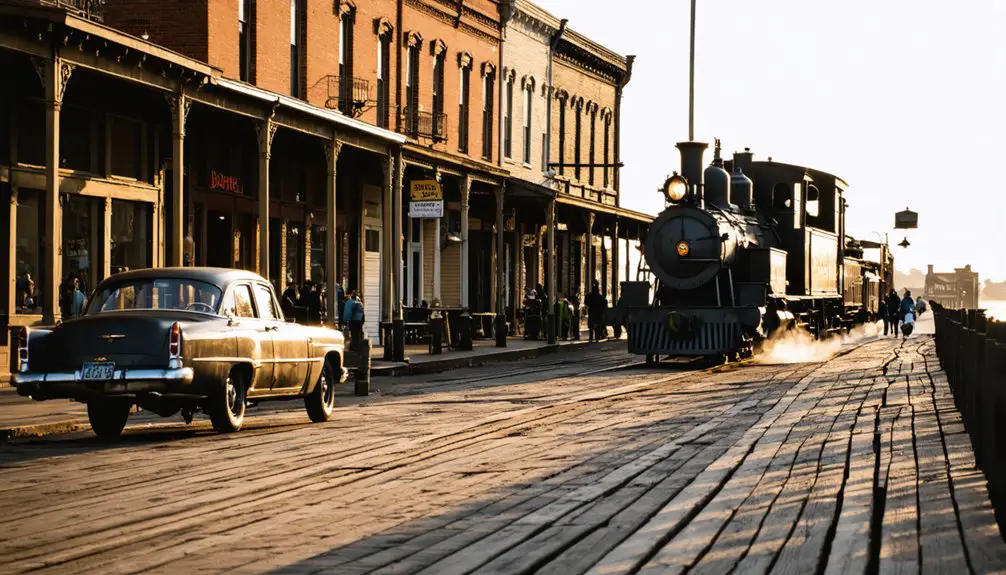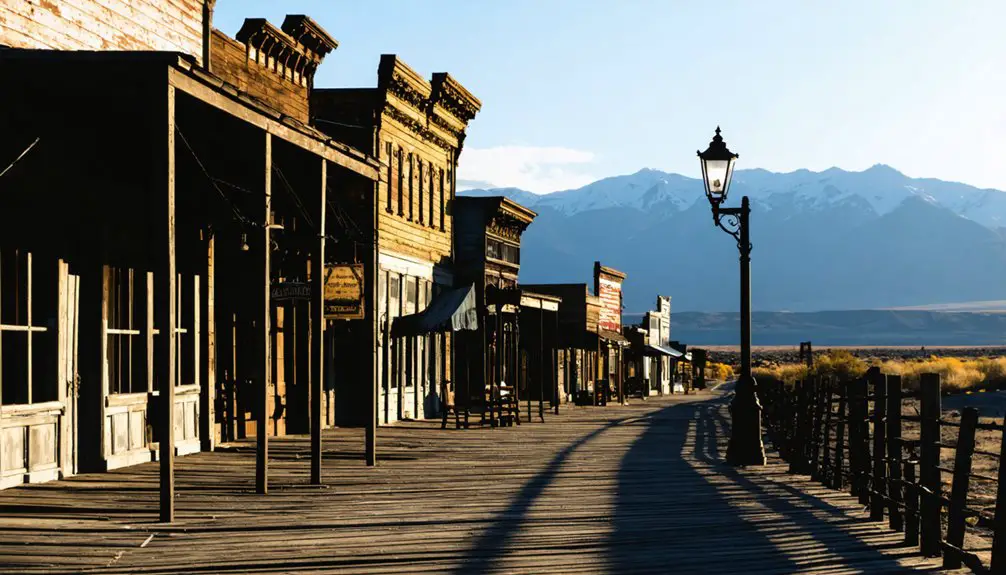You’ll find Virginia City, Nevada perched high in the Sierra Nevada Mountains, where the 1859 discovery of the Comstock Lode triggered America’s richest silver strike. This National Historic Landmark transformed from a tent settlement into a sophisticated Victorian-era metropolis, producing over $400 million in precious metals (equivalent to $20 billion today). While its population declined from 25,000 to 500 by 1930, its preserved architecture and authentic saloons reveal an extraordinary chapter of the American West.
Key Takeaways
- Virginia City is not a true ghost town, as it maintains a small population and receives over 1.2 million tourists annually.
- The city declined from 25,000 residents during its 1870s peak to just 500 by 1930 after silver deposits were depleted.
- Nearly 300 original structures remain preserved, with the town designated as a National Historic Landmark in 1962.
- The historic district features authentic Victorian architecture, restored saloons, and preserved buildings from the 1860s mining boom era.
- Tourists can experience the town’s mining heritage through guided tours, historic buildings, and cultural events celebrating its prosperous past.
The Birth of a Silver Empire
While modest placer mining operations had existed in Gold Canyon for nearly a decade, the discovery of the Comstock Lode in 1859 transformed Virginia City into the epicenter of America’s most significant silver strike.
Though Henry Comstock received official credit, you’ll find that Irish immigrants James McLaughlin and Peter O’Riley were the true discoverers of this remarkable deposit.
The initial find sparked a silver rush that rivaled California’s legendary gold rush, attracting thousands of ambitious prospectors.
As mining technology advanced to tackle the challenging blue mud containing precious metals, Virginia City exploded from a tiny settlement into a thriving industrial powerhouse. By 1860, the area had grown into a bustling chaotic tent city with several thousand residents.
The wealth generated from silver mining helped establish secondary businesses like saloons, hotels, and general stores throughout the booming town.
Mark Twain’s Wild West Days
After failing as a prospector in 1862, Samuel Clemens found his true calling as a writer for Virginia City’s *Territorial Enterprise*, where he first adopted the pen name “Mark Twain.”
His time at the newspaper marked a pivotal transformation from inexperienced journalist to masterful storyteller, as he developed his signature style of blending factual reporting with humorous exaggeration. The perilous nineteen-day journey from Missouri had prepared him for the wild tales he would tell about the frontier.
Clemens’s transformation into Mark Twain embodied the spirit of frontier journalism, where he’d craft colorful dispatches about local events, politics, and ghost stories that captivated readers. Under the mentorship of Joseph T. Goodman, founding editor of the Enterprise, he honed his skills covering everything from local vice to mining news.
His experiences in Virginia City’s saloons and opera houses later inspired his 1872 book *Roughing It*, forever immortalizing the raw energy and untamed character of the American West.
You can trace his literary evolution through his coverage of the bustling silver boomtown‘s parades, civic activities, and legislative sessions.
Life in the Richest Mining Town
The discovery of the Comstock Lode transformed Virginia City into one of America’s wealthiest frontier settlements, where miners extracted more than $400 million in gold and silver during the boom years – equivalent to over $20 billion today.
You’d find a mining lifestyle unlike any other frontier town, with skilled miners earning top wages of $3.50 daily. The harsh environment led to miners being called Hot Water Plugs due to the extreme temperatures they endured underground.
The city’s social dynamics reflected unprecedented prosperity, boasting 110 saloons, 20 theaters, and a luxurious 100-room hotel complete with an elevator.
Virginia City’s riches spawned extravagant amenities, from lavish theaters and countless saloons to a grand hotel with modern conveniences.
You’d witness a cosmopolitan atmosphere where European furnishings adorned mansions, and entertainment from across the globe graced opera houses.
The population swelled to 25,000 by the mid-1870s, creating a diverse community served by three daily newspapers, modern infrastructure, and cultural institutions that rivaled established Eastern cities.
Despite the wealth and glamour, miners faced treacherous working conditions with iron cage accidents claiming hundreds of lives throughout the mining operations.
Vigilantes and Villains
Due to inadequate law enforcement during Virginia City’s explosive growth, prominent citizens formed vigilance committees in the early 1860s to combat rampant crime. Local bankers, miners, and businessmen took vigilante justice into their own hands, establishing a system of swift punishment for wrongdoers. Their enforcement included sounding community alarm bells at noon to gather members for action. The discovery of gold at Alder Gulch fueled the town’s rapid expansion.
They’d warn undesirables with ominous “601” notices or the mysterious “3-7-77” symbol, demanding immediate departure within 24 hours.
The committee’s most significant action came in 1864 when they exposed criminal conspiracies led by Sheriff Henry Plummer himself. You’d have witnessed the dramatic public hangings of Plummer and over 24 road agents during this period.
While the vigilantes initially maintained order effectively, their power eventually corrupted them. By 1867, accusations of bullying and criminal collusion led to their disbandment, though their impact on Virginia City’s history remains legendary.
Architecture Through Time
You’ll find Virginia City’s architectural heritage dominated by late Victorian styles, including Italianate commercial buildings, Gothic Revival churches, and elegant Queen Anne residences that emerged during the silver boom of the 1860s and 1870s.
The devastating fire of 1875 led to rapid reconstruction using fire-resistant materials like brick and stone, while maintaining elaborate Victorian elements in structures such as the Fourth Ward School and Territorial Enterprise Building. The historic area welcomes nearly a million visitors annually.
Today, preservation efforts through the Comstock Historic District Commission guarantee these original buildings continue to reflect the town’s remarkable evolution from mining boomtown to historic landmark. These buildings showcase the rich gold history with an estimated $100 million in gold extracted throughout the 18th and 19th centuries.
Victorian Elegance Meets West
While most frontier towns of the American West exhibited hastily constructed wooden structures, Virginia City emerged as a remarkable fusion of Victorian sophistication and Western practicality.
You’ll find this unique blend most prominently displayed along C Street, where ornate Victorian craftsmanship adorns commercial buildings constructed from rustic materials like brick and iron.
The devastating fire of 1875 led to a transformative rebuilding period, during which the town embraced fire-resistant construction while maintaining Victorian elegance.
Today, you can explore the town’s carefully preserved architectural heritage, from the grand false-front façades to the decorative wooden trim work.
The combination of steep terrain and grid-pattern streets creates dramatic vistas, where Victorian-era buildings stand proudly against Nevada’s rugged basin and range landscape.
Building Materials and Methods
As Virginia City rapidly transformed from a mining camp into a thriving metropolis, its architectural evolution reflected the community’s growing permanence and prosperity.
You’ll find the earliest structures utilized readily available building materials like wood for V-notched log cabins and simple frame buildings, prioritizing speed during the 1859 silver rush.
As the town matured, construction techniques advanced markedly. Brick and masonry replaced wooden structures, particularly in commercial buildings, addressing fire safety concerns while adding durability.
These two- to three-story buildings featured practical mixed-use designs with ground-floor shops beneath living quarters. The structures incorporated sturdy combinations of masonry and timber framing to withstand both harsh Nevada weather and mining vibrations.
Victorian architectural influences emerged in brick facades, while wooden boardwalks became a distinctive feature of the streetscape.
Preservation of Original Structures
Since its designation as a National Historic Landmark in 1962, Virginia City’s architectural preservation has become a model for heritage conservation in the American West. The Bovey family led these efforts by acquiring and restoring over 100 original buildings, implementing restoration techniques that maintained architectural integrity while adapting structures for modern use.
You’ll find nearly 300 authentic buildings that showcase meticulous preservation work, including careful moisture control, structural repairs, and period-appropriate restoration.
The town’s preservation teams have focused on suspending material deterioration while retaining historic authenticity, as seen in landmarks like the Bale of Hay Saloon and Judge Blake House.
Through these efforts, Virginia City’s buildings continue to serve dual roles as both historic sites and functional spaces, creating a living museum that reflects the town’s peak mining era.
Cultural Legacy of the Comstock

Because the Comstock Lode transformed Virginia City into a wealthy mining hub, its cultural legacy endures through architectural treasures, technological innovations, and social institutions.
You’ll find evidence of cultural diversity in the town’s rich mining traditions, where immigrants from around the world converged to create a vibrant community that flourished during the 1870s.
- The establishment of 110 saloons, theaters, and music halls showcased the town’s dynamic entertainment scene.
- Advanced mining techniques like square set timbering and the Washoe process revolutionized mineral extraction.
- The construction of impressive structures, including a six-story hotel with the West’s first elevator outside Chicago.
- The development of essential social institutions such as churches, schools, and banks that supported the booming population.
This remarkable heritage captures the spirit of American frontier ambition and resilience.
Legends and Hauntings
You’ll encounter some of Virginia City’s most infamous haunted sites at Piper’s Opera House, where a red-eyed shadow creature and phantom dancer are known to materialize in the balcony.
The town’s abandoned mine shafts beneath the streets harbor dark legends, including John Mackay’s alleged demonic pact that brought him unprecedented wealth from the Comstock Lode.
As night falls over Boot Hill, the spirits of miners and townsfolk from Virginia City’s turbulent past are said to wander through Silver Terrace Cemetery‘s Victorian graves, making it a focal point for paranormal investigators and ghost tours.
Haunted Opera House Tales
While Piper’s Opera House stands as a symbol to Virginia City’s cultural legacy, its reputation for paranormal activity rivals its historical significance.
You’ll find a building steeped in tragedy and triumph, where ghostly encounters range from unexplained sounds to full spectral performances. The opera house’s turbulent past, including an 1871 lynching and multiple devastating fires, has left an indelible mark on its supernatural character.
- Victorian-era apparitions frequently appear on or near the stage where legendary performers once stood
- Unexplained footsteps, voices, and phantom piano music echo through empty halls
- Visitors report dramatic temperature drops throughout the building
- Objects move mysteriously, especially in the balcony and backstage areas
These paranormal activities, combined with the venue’s connections to Mark Twain and other luminaries, create an unforgettable haunted destination.
Cursed Mines Below
Beneath Virginia City’s haunted opera house lies an even darker domain of supernatural activity – the infamous Comstock mines.
You’ll encounter a rich tapestry of cursed legends woven from countless mine accidents and ghost sightings that have shaped the lore of these treacherous tunnels.
The mines’ notorious reputation stems from frequent cave-ins and floods that claimed numerous lives, spawning reports of shadowy figures and unexplained lights near fatal accident sites.
Miner superstitions emerged from a blend of multicultural beliefs – Irish miners contributed Celtic ghost stories, while Chinese workers added traditional spirits of disturbed earth.
You’ll find the most chilling tales center around the “Devil’s Hole” and its unexplained deaths.
Even today, visitors report hearing disembodied footsteps and voices echoing through the abandoned shafts.
Boot Hill After Dark
After nightfall descends on Virginia City’s Boot Hill Cemetery, the haunting legacy of its notorious residents emerges through persistent tales of supernatural activity.
You’ll find this historic burial ground, where five infamous road agents met their end at the hands of Vigilantes in 1864, steeped in ghostly encounters and cemetery folklore.
- Unexplained noises and apparitions are frequently reported near the graves of executed outlaws
- The mysterious Vigilante code “3-7-77” adds to the cemetery’s dark mystique
- Local legends suggest the spirits of hastily buried criminals remain restless
- Paranormal investigators are drawn to “Murderer’s Row” where marked tombstones tell tales of frontier justice
The violent deaths and swift burials of Boot Hill’s residents have created an enduring supernatural reputation that continues to captivate visitors exploring Virginia City’s haunted history.
From Boom to Near Bust
Although Virginia City reached extraordinary heights of prosperity during the 1860s and early 1870s, its fortunes began to shift dramatically by 1877 as the Comstock Lode‘s rich surface ores became depleted.
You’ll find that mounting mining challenges and increasing operational costs sparked a gradual economic decline that transformed this once-mighty boomtown.
While the city had previously boasted a population of 25,000 residents, sophisticated amenities, and over 110 saloons during its peak, these glory days wouldn’t last.
By 1930, you’d have found only 500 inhabitants remaining in what was becoming a near-ghost town.
Despite this downturn, Virginia City’s legacy endured through its contributions to Nevada’s statehood, Western mining innovations, and the lasting impact of its tremendous wealth on America’s monetary systems and regional development.
Modern-Day Time Capsule

While Virginia City‘s mining heyday has long passed, the town serves as a remarkable time capsule of 19th-century Western architecture and culture.
Through dedicated historic preservation efforts, you’ll find yourself immersed in an authentic mining town atmosphere, where original buildings like The Washoe Club and Piper’s Opera House stand as evidence to the Comstock era.
- St. Mary’s in the Mountains Catholic Church, Nevada’s oldest Catholic church, has survived multiple fires since 1868.
- The Washoe Club, built in 1875, features original woodwork and mirrors, attracting time capsule tourism enthusiasts.
- Piper’s Opera House maintains its ornate 1885 stage and molding, preserving performance culture.
- Nearby ghost towns like Gold Hill offer quieter historical experiences with minimal tourist development.
The town’s unchanged street layout and preserved boardwalks allow you to walk the same paths as 19th-century miners, creating an unparalleled connection to the American West.
Heritage Tourism Experience
Today’s heritage tourism experience in Virginia City draws over 1.2 million annual visitors seeking authentic encounters with the American frontier.
You’ll discover a National Historic Landmark District where heritage tours showcase preserved 1800s architecture, including the iconic Fourth Ward School museum and Piper’s Opera House.
The town’s cultural events celebrate its multicultural mining heritage through performances, exhibits, and interactive experiences.
You’re free to explore authentic saloons, participate in guided historical walks, and immerse yourself in the distinctive nightlife that once attracted figures like Mark Twain and Ulysses S. Grant.
Step into Virginia City’s historic saloons and vibrant nightlife, walking the same streets where Mark Twain and President Grant once roamed.
Despite COVID-19’s impact on tourism revenue, Virginia City’s preservation initiatives continue to maintain its frontier-era character, supporting 85 small businesses and providing visitors with genuine connections to Nevada’s mining boom legacy.
Frequently Asked Questions
What Were the Average Wages for Miners in Virginia City’s Peak Years?
You’d have earned $3.50 daily as a miner in the early 1860s, rising to $4.00 by the 1870s, despite harsh mining conditions and wage disparities between skilled and unskilled workers.
How Did Residents Get Fresh Water and Food Supplies to the Town?
Though you’d think a desert town would struggle, you’d get your water from the impressive Marlette Lake System’s 21-mile network, while railroads and wagons brought food through established supply routes.
What Happened to the Indigenous Peoples Who Originally Inhabited the Area?
You’ll find that indigenous displacement forced Northern Paiutes from their lands, pushing them to town outskirts where they faced cultural assimilation while working menial jobs and scavenging from mining operations.
How Did Children Receive Education in Virginia City During the Boom?
You’d find schooling methods centered at Fourth Ward School, where children’s curriculum included primary subjects through high school, with state-of-the-art facilities serving over 1,000 students during Virginia City’s prosperous era.
What Role Did Chinese Immigrants Play in Virginia City’s Development?
You’d be shocked how Chinese immigrants’ contributions shaped everything – from building essential infrastructure to running businesses. They endured harsh labor conditions while creating Virginia City’s economic backbone through mining, commerce, and services.
References
- https://www.rv.com/archive/virginia-city-and-nevada-city-living-ghost-towns/
- https://www.realgirlreview.com/virginia-city-nevada-ghost-town/
- https://visitvirginiacitynv.com/history/
- https://www.atlasobscura.com/articles/gold-ghosts-and-gin-the-curious-spirits-and-elaborate-history-of-virginia-city
- https://sherilyndecter.com/virginia-city-from-ghost-town-to-tourist-mecca/
- https://westernmininghistory.com/towns/nevada/virginia-city/
- https://www.silverlandinn.com/newsroom/virginia-city-history
- https://en.wikipedia.org/wiki/Comstock_Lode
- https://nbmg.unr.edu/scienceeducation/ScienceOfTheComstock/Tour-Mining.html
- https://en.wikipedia.org/wiki/Mark_Twain_in_Nevada



